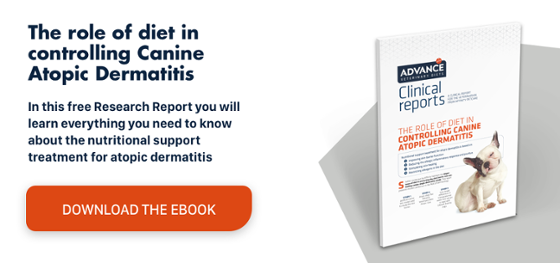Dermatitis in dogs and how it affects their quality of life
The signs of this disease only tend to appear in dogs over 1 year old. Changes in the patient’s itching and skin may be very slight and barely noticeable in younger dogs, and affected dogs usually begin to show signs between the age of 1 and 3 years, which worsen as the skin becomes more sensitive.
Clinical signs of atopic dermatitis
The signs of dermatitis generally tend to be localised to the face, ears, axillae, groin, perineum, paws and limbs; although in some cases they occur in a generalised pattern across the patient’s entire body. The most common signs are:
- Inflammation
- Pruritus
- Erythematous macules
- Papules
- Areas of alopecia
- Areas with a bacterial infection or pyoderma
- Bloody scabs
What are the most common causes?
Some breeds are more susceptible (e.g., West Highland White Terrier, French Bulldog, Shar Pei) and genetic inheritance is a key factor, causing a markedly higher incidence; however, the problem is always triggered by an allergen, the most common ones being:
- Pollen
- Dust mites
- Dander (skin cells from other animals)
- Mould
- Household cleaning products
- Fertilisers
- Sensitivity to certain medications or a dietary constituent
Treatment of CAD
The treatment options available have different efficacies, side effects and costs. As it is an incurable disease, it requires lifelong treatment, an important fact which must be explained to the owners of dogs with CAD. Appropriate therapeutic measures and lifestyle changes will improve the animal’s clinical picture.
No single therapy is 100% effective in atopic dermatitis. Most dogs require a combination of treatments to control the disease, with one core treatment supported by one or two additional therapies selected according to the patient’s underlying medical conditions, the severity of the allergy and the primary signs.
Conventional measures include systemic glucocorticoids, essential fatty acids, dietary antihistamines, allergen-specific immunotherapy and shampoo treatment.
How does it affect quality of life?
Atopic dermatitis negatively affects both pets and owners as it has a significant impact on the daily life and well-being of dogs and creates frustration in owners: frequent visits to the vet’s clinic, flare-ups, financial costs, the administration of care and therapy that does not provide a definitive solution, the dog’s constant scratching, the bad smell that often accompanies this skin disorder, and so on.
Owner education and close collaboration with the veterinary team is key to an effective long-term treatment in atopic dogs.
CAD can lead to psychological stress due to its recurrence and degree of severity. A study comparing dogs with mild, moderate and severe atopic dermatitis, plus another group of healthy dogs, found that hairs taken from subjects with CAD had significantly higher cortisol concentrations than healthy dogs.
A characteristic feature of this disease is the deterioration of the epidermal skin barrier, which increases transepidermal water loss (TEWL) and dehydrates the skin. There is a correlation between its severity and cortisol levels in the hair. This is an effective and objective biological marker for assessing long-term stress in this disease.


